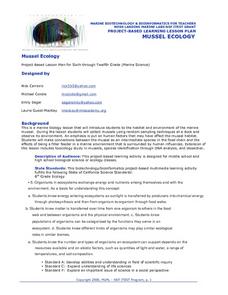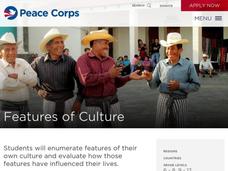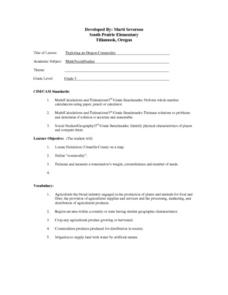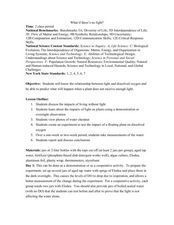Curated OER
Where Does It Come From?
Students explore where agricultural commodities used in snack foods are grown. They choose a snack food and locate the top five states that produce the food that the snack is made from.
Curated OER
Prosperity and Challenges
High schoolers watch a slideshow about the technological advances in agriculture. After viewing, they complete an index card about one aspect of the slideshow. In groups, they create a cause and effect timeline in which they identify...
Curated OER
Galileo's Thermometer: Measuring the Density of Various Unknown Liquids
Sprouting scientists explore the concept of density by making mass and volume measurements for five different liquids. From these measurements, they calculate densities. They apply their learning to explain Galileo's thermometer works...
Curated OER
Basics of Environmental Science
Ninth graders explore environmental concerns of the community and identify the basic needs of people, wildlife and domestic animals. Working both individually and in groups, they also define natural resources and compare and contrast...
Curated OER
Horatio's Ratios
View a PBS video entitled Horatio's Drive and explore Horatio's Ratios. Collaborative learners form groups to use Mapquest to determine distances covered. They generate the mathematical averages, ratios, and rates in order to calculate...
Curated OER
Be An Expert
Part of a series of lessons about bring Native American stories into the classroom, this plan suggests having kids research and take notes on one group of Native Americans and then complete a project that they present to the class. Pull...
Curated OER
Life is Weird
Separate your science class into small groups and assign each a specific deep-sea organism to research. The class will learn about all of the organisms as each group presents their assigned animal. Following their presentations, you can...
Curated OER
Seepy Sandwich
Students explore Earth science by participating in a pollution activity. In this water infiltration lesson plan, students utilize a water sprayer, food coloring and slices of bread to simulate how pollution can spread into our drinking...
Curated OER
Puffin Patrol
Bird diversity and the majestic puffin are the topics of today's lesson. Children discuss and look at images of puffins, and then they use felt to put a puffin body together. After that they talk about what and how puffins eat. They get...
Curated OER
Thanksgiving Placemats: A Community Service Project
Students complete a community service project to brighten the holidays. They work together at a food kitchen or shelter. They reflect on their experiences.
Curated OER
Mussel Ecology
Students are introduced to the marine environment of the mussel. The emphasis of the lesson is upon what human factors are present to influence the environment in positive and negative ways. They brainstorm in groups in order to conduct...
Curated OER
Anasazi Basket Weaving
The Anasazi Indians of Mesa Verde are the focus of this art and social studies lesson. Working in pairs or groups of three, students utilize computers and go online to search for websites about the Anasazi. Students will choose two or...
Curated OER
Features of Culture
Students examine features of cultures. In this cultural diversity lesson, students explore 5 features of culture as they compare their cultural traditions to the traditions in other cultural groups.
Curated OER
Exploring and Oregon Commodity
A fun (and delicious!) lesson teaches measurement to your third graders. They work in small groups to first predict, then to measure the weight, circumference, and number of seeds found in a watermelon. Everyone gets to eat watermelon...
Curated OER
Matters of Milk and Marshmallows
Pupils observe a teacher demonstration o classifying matter by its physical properties of shape and size. After discussing the definition of matter, students describe the state of matter. They sing a song to the tune of "Bingo." In...
Curated OER
My Problem...Your Problem...Our Problem
Sixth graders list challenges they face in life and identify which challenges deal with people and relationships. In groups, they participate in conflict-resolution activities. Afterward, 6th graders present real-life situations and...
Curated OER
Creating a Wild Family Album
Third graders choose an animal to research and create a portfolio about that animal that includes information from at least three resources, a graphic organizer, maps, food webs, and captioned pictures.
Curated OER
Hierarchy Theory and Biotic Hierarchy
Learners examine the hierarchy theory and biotic organization by playing a teacher-created card game matching groups of items, such as organelles, in suits of four. They discuss the reasons for their hierarchical organization of the...
Curated OER
The Wonderful World of Slugs
Examine a slug? Of course, what else would a 2nd grader do with it? Pupils use clues and go on a slug hunt, read a slug story, or make a cooperative group mural of a slug's habitat. While older learners catalog slugs, go on a slug hunt,...
Curated OER
Cultural Awareness/Sharing Traditions
Students examine and explore cultural traditions that make their own families unique. In groups, they discuss traditions, write about the similarities and differences in the group, and interview other students.
Curated OER
Leach Out and Touch Someone
Students discuss how groundwater becomes polluted. In groups, they design and create models of groundwater pollution sources. They demonstrate to the class how the water may become contaminated from local and nonlocal pollution sources.
Curated OER
Watch Them Grow
Students explore the growth of plants and animals. Through research and observation, students create a habitat for specific plans and animals. As a group, they examine the similarities and differences of living things. Students identify...
Curated OER
Similar and Different
Fourth graders observe a pair of students standing in front of the class and compare and contrast them using a Venn Diagram using these guidelines: eye color, hair color, older/younger, tallest/shortest, gender, favorite food, favorite...
Curated OER
What If There's No Light?
students discuss the importance of light and the consequences of living without it. Using a plant as a demonstration, students predict and observe what happens to a plant when it does not receive enough light. In groups, they experiment...

























